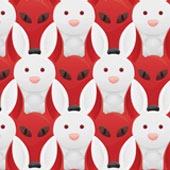This is an exercise in exploring Figure and ground relationships. Tessellation can be thought of as figures that fills a plane surface with no overlaps and no gaps. We can also make a tessellation when figures are repeated alternately with ground (without overlapping).

We are able to see figure as distinct from the background. In a tessellation since the figures are repeated alternatively with the background, we are able to see the background also as figures or the figures as background. In fact, you can switch between the figure and background. This is easily seen in this image below - two faces and the vase.


The pictures have a double reality. They are objects in their own right (patterns on a flat sheet) and at the same time entirely different objects to the eye. Pictures are paradoxes. The retinal images do not have the double reality of external pictures. We do not see them as patterns and as representing something else. We read aspects of reality from the patterns in the eyes, but we do not also see our eyes’s images.
___by Gregory Richard L; Visual Illusions, Scientifics America, November 1968
Interpretation-hypothesis:
Perception may be search for the best possible interpretation of sensory information, based on our knowledge of object characteristics. In other words, a perceived object may be a hypothesis suggested by the sensory data. The perceptual system is active, this system does not merely receive input, but also searches for the percept that is most consistent with the sensory data.
___by Gregory Richard L; the intelligent eye, McGraw hill, 1971
The Dutch artist M C Escher (1898-1972) created some of the most interesting tessellations. Here is a woodcut depicting tessellation titled 'sky and water' by the artist:


